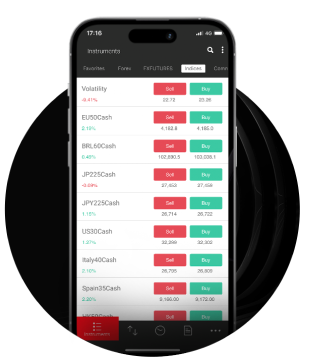When it comes to forex trading, being able to read the markets and speculate on the direction a price of an asset will take is your bread and butter. If you want to grow as a forex trader and continue enriching your skills, developing a knack for reading and understanding price movements is very important. This is what technical analysis and its tools do and forex traders should ensure they integrate technical analysis into their daily routine.
Summing up what technical analysis is
Technical analysis (TA) is the study of past price data to forecast future market behaviour. Unlike fundamental analysis that focuses on economic reports or central bank policies, TA looks at charts, patterns and indicators to visualise market psychology.
Tools to help conduct your technical analysis
Price charts
A price chart visualises the movement of currency pairs over time and helps traders identify various trends and patterns. The simplest chart is the line chart which connects the closing prices with a line. Traders use it for spotting major trends in a hurry.
A bar chart displays the open, high, low, and close for each time period and offers traders more detail about price volatility.
Candlestick charts are the most popular charts among forex traders. Each “candle” depicts the open, close, high, and low prices of a currency, colour-coded to reflect bullish or bearish momentum.
Charts are not only visual representations to help guide traders but they are also used as the canvas on which to superimpose tools-indicators, patterns and trendlines so traders can interpret market behaviour with precision.
Trendlines and channels
Tracking market direction is done with the help of trendlines and channels.
A trendline is a simple straight line that connects two or more important price points and graphically indicates the general direction of the market.
An uptrend for example depicted by the higher highs and higher lows means that buy opportunities may appear at pullbacks to the trendline.
Downtrend: lower highs and lower lows. Traders look for sell setups near resistance.
When we see a sideways/range, then traders know the price is swinging between support and resistance, which denotes consolidation.
A price channel takes this concept one step further by adding a parallel line, thus capturing both the upper and lower bounds of price movement. Channels help identify breakout opportunities when the price moves decisively outside the range.

Support and resistance
Market psychology can be seen by support and resistance levels. A level of support is one at which demand (buying interest) is strong enough to prevent a further decline. Resistance is the level at which selling pressure usually stops upward momentum.
In such cases, when price breaks out of a key support or resistance level, it reflects a change in sentiment because usually there are reversals or continuations of trends. Knowing where buyers and sellers are likely to step in can enable you to anticipate price reactions, set effective stop losses, and target realistic profit zones.
Moving Averages
Smoothing the noise and detecting the real trends is the job of Moving Averages (MAs). The price action can be noisy but MAs smooth these fluctuations out to show the real underlying trend.
The Simple Moving Average (SMA) is the average of the prices over a selected length, such as the 50-day SMA.
The EMA, or Exponential Moving Average assigns more value to recent prices, thus reacting faster to new information.
Popular Strategies:
- Crossover Method: A short-term MA such as the 20 EMA crosses over a longer-term MA like the 50 EMA, which is indicative of bullish momentum, and vice versa.
- Dynamic Support/Resistance: Price often bounces around major MAs, like the 200 SMA, which many institutions monitor closely.
Moving averages are one of the most valued trend indicators as they assist traders with confirming a direction, smoothing out emotional decision-making and acting as entry or exit triggers for trading systems.
Relative Strength Index (RSI): Identifying Momentum and Reversals
Among the most popular momentum oscillators is the Relative Strength Index. The speed of the movement in price and the change thereof in magnitude are measured within a range from 0 to 100.
Above 70: Overbought. The price may be due for a correction. Below 30: Oversold: means there is a potential buying opportunity.
Advanced traders use RSI to identify divergences when the price makes new highs/lows but RSI doesn’t follow. Divergences usually mean that momentum is weakening and a reversal might be near.

Moving Average Convergence Divergence (MACD)
Tracking trend and momentum together is something that can be done with the help of the MACD.
The MACD blends the best of both worlds by tracking both trend direction and momentum strength.
It comprises two lines: the MACD line, which is a difference between two EMAs; another line, called the Signal line, which is an EMA of the MACD line; and a histogram showing their divergence.
MACD does a lot of things: it confirms trends, gives momentum shifts and points to reversals. Most traders combine it with moving averages to get a clearer picture of the market.
Fibonacci Retracement
Measuring where the market pulls back and retraces is very important in trading. For example, traders expect a retracement after a strong price move, because you either have traders taking profits or new ones are joining at better prices.
So if you want to determine potential levels where the price might pull back and then continue its trend, the Fibonacci retracement tool is the perfect tool. If the EUR/USD rises from 1.0500 to 1.1000, then, let’s say, a 50% retracement would be near the 1.0750 mark, indicating a potential buy zone if the trend remains bullish.
Bollinger Bands
Measuring volatility can be done with Bollinger Bands which was developed by John Bollinger. They are made up of three lines:
A middle line, usually a 20-period SMA,
An upper band SMA + 2 standard deviations,
A lower band: SMA – 2 standard deviations.
When the bands expand, we see that volatility is increasing but when they contract, then volatility is decreasing, often followed by a breakout.
Bollinger Bands help traders understand the dynamics of volatility as they are important for setting stop losses, identifying breakout conditions, or timing entries.
Volume Indicators
Popular volume indicators such as On-Balance Volume or various Volume Oscillators help traders confirm price action and gauge market activity. If the volume and price increase then it reveals a strong trend, but if the volume remains low and only the price increases, then it may show exhaustion.
Grafiekpatronen
Reading the market with chart patterns offers a visual representation of the market’s psychology and helps traders form a better image of what to expect from prices in the future.

Understanding probabilities
Technical analysis is about understanding probabilities and not just making predictions. Each tool sheds light on different aspects of the market such as momentum, trend, volatility and psychology. While understanding these tools and using them doesn’t guarantee you won’t make mistakes, it will nonetheless help you gather more information and make better decisions. So, it is always good to start small: choose a few of these tools, backtest them and integrate them into your trading routine. Over time, your charts will stop looking like noise and start guiding you, showing you the secrets of the markets and revealing their own story
Disclaimer: This information is not considered as investment advice or an investment recommendation, but instead a marketing communication. IronFX is not responsible for any data or information provided by third parties referenced, or hyperlinked, in this communication.
















